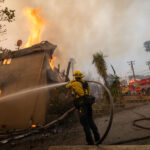In the entire state of Louisiana, there are only 16 of them, and they want business.
They are certified wind inspectors, and for $150 to $200 they say they can knock hundreds of dollars off homeowners’ annual insurance premiums.
“I drive down the street and say ‘discount, no discount, discount, no discount,”‘ said Bill Hatchett of Harvey, one of the first licensed wind inspectors in Louisiana.
Hatchett was certified in 2009, after insurance discounts were made mandatory for wind damage mitigation on homes through an updated state construction code.
“Unfortunately, I would say the great majority of consumers are not aware of it,” state Insurance Commissioner Jim Donelon said. “And some are also not in a position to front the cost of these retrofitting requirements to access the discounts, even though the Legislature made tax breaks in 2007.”
But some homeowners may already be sitting on them and not know it.
Marc Orgeron of Gretna said he has done about 20 wind-specific inspections since becoming a certified wind inspector about a year ago, several of which have been in the New Orleans area.
He claims a woman in New Orleans East had her annual premium lowered $1,000 “just because she had a hip roof.”
A hip roof, one that has four sides that meet in the middle, rather than just two sides reaching a peak, is the most common way homeowners can see an instant drop in their premiums, home inspectors said.
It’s one aspect of wind damage mitigation that ties in with what Louisiana Department of Insurance actuary chief Richard Piazza calls a “matrix” of possibilities that involve seven categories of upgrades to the home, each with their own subcategories. They include the way the roof is latched to the home to items as simple as storm shutters.
Some wind inspectors who have been through the process have found it confusing.
Certified inspector Charles Gagnet, based in Luling, said he has seen percentages fluctuate on how much insurance companies will reduce premiums. Also a mystery is how much proof the insurer will require before doling out the discount. Some insurance companies want to see pictures of the roof, while others will settle for blueprints, Gagnet said.
“It depends on the insurance company,” Orgeron said. “Some of them are real short; one today did not ask for a lot of in-depth information. It’s going to vary depending on carrier.”
Wind inspectors say various insurance companies use different forms for evaluating mitigation work, which can create confusion. Some safety attributes are impossible to detect entirely based on the insurance standards, they said.
“Some of the forms have questions that really you can’t answer unless you see the house under construction,” said Harry Crosby of Mandeville, who said he was compelled to become a wind inspector after getting calls from insurance agents asking him if he could perform the task.
In the few inspections he has performed, Crosby said he has seen homeowners get discounts for simple repairs or upgrades done after Hurricane Katrina.
But under Insurance Services Office standards, which cover about half of the insurance providers in the state, homeowners can get discounts of up to 28 percent in the southern part of the state, up to 20 percent in the central region and up to 14 percent in areas such as Monroe, Piazza said.
The discounts and certification program, which didn’t take effect until 2009, come from a special session of the state Legislature called by then-governor Kathleen Blanco two months after hurricanes Katrina and Rita. The session produced new construction code standards.
Donelon argued that at least from the standpoint of an updated building code, the program has had success. The evidence, he said, was seen during a flyover of lower Terrebonne Parish after Hurricane Gustav, when he saw the upgraded construction standing nearly unscathed next to piles of rubble, the latter being homes that were not up to date.
The same was true in Southwest Louisiana in 2008 when Hurricane Ike brushed over an area of Holly Beach on its way to Galveston, Donelon said.
Meanwhile, Louisiana Citizens CEO John Wortman said the state-backed insurer of last resort is readying itself for another round of customer reductions in December, when it could shed another 5,000 to 10,000 policyholders to private companies.
Like Donelon, Wortman said the updated building codes have helped ease the paranoia of offering insurance in a state that saw the most expensive disaster in U.S. history, racking up $45.3 billion in insured losses.
“I tell re-insurers that Louisiana is better off today than pre-Katrina,” he said.
Information from: New Orleans CityBusiness
Was this article valuable?
Here are more articles you may enjoy.


 Twice Injured Firefighter Loses Second Workers’ Compensation Claim
Twice Injured Firefighter Loses Second Workers’ Compensation Claim  Cessna Jet Tied to Nascar Driver Greg Biffle Crashes in North Carolina
Cessna Jet Tied to Nascar Driver Greg Biffle Crashes in North Carolina  Catastrophe Bonds Linked to Wildfires Lose ‘Untouchable’ Status
Catastrophe Bonds Linked to Wildfires Lose ‘Untouchable’ Status  CEO Sentenced in Miami to 15 Years in One of the Largest Health Care Fraud Cases
CEO Sentenced in Miami to 15 Years in One of the Largest Health Care Fraud Cases 

